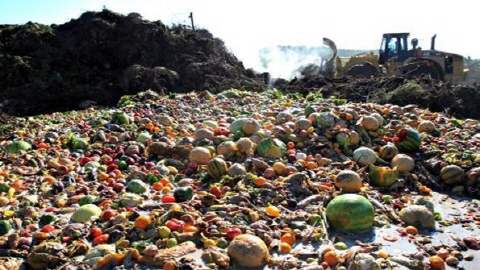
Keeping Food on the Plate, and Out of Landfills
While many still go hungry in the United States, as much as 40 percent of the food sold to consumers goes into the garbage, either at stores or after it is purchased. Industrialized countries waste about as much food as is produced in sub-Saharan Africa. Millions are spent growing, processing, transporting and disposing of food that just ends up in landfills. What can be done to reduce food waste?
* go hungry = 굶주리다; 배고프다/ as much as ~ = ~만큼, ~정도/ industrialized = 산업[공업]화된/ dispose of ~ = ~을 처리하다[없애다]/ end up in ~ = 결국 ~로 끝나다[~에 처하게 되다]/ landfill = 쓰레기 매립지/ food waste = 음식 찌꺼기
 음식 찌꺼기를 줄이기 위해 무엇을 할 수 있나요?
음식 찌꺼기를 줄이기 위해 무엇을 할 수 있나요?
1. Simple Steps by Consumers Can Curb Food Waste
Shop, store and cook intelligently. Buy less, freeze more, Google ways to cook up leftovers, and
don't freak out bout "buy by" dates.
2. Eliminate Laws That Cause Healthy Food to Go to Waste
In the absence of federal law on date labels, no two states have the rules.
Several states even restrict or ban the sale or donation of past-date foods, even if they are still fresh.
3. Connect Retailers to Surplus Outlets
Because food is uniquely perishable, decisions by grocers and restaurants about what to do with surplus
are made quickly.
4. Ease Hunger With a Better Food Rescue System
The government should encourage businesses to donate funds and excess food to local food banks.
Sample Essay
Simple Steps by Consumers Can Curb Food Waste
The next time you toss out a burger, imagine taking a 90-minute shower. That’s how much water it took to produce that burger and get it to you.
Wasting food wastes everything. Americans trash more than one-third of our food supply and throw out the equivalent of nearly a quarter of our water supply in the form of uneaten food. Growing and transporting all that food spews out the same amount of carbon pollution as 39 million passenger vehicles. To add insult to injury, food is the single-largest contributor to U.S. landfills.
We, as consumers, are responsible for the largest share of food going to waste — about 40 percent. But that also means we have the power to make a tremendous difference. In fact, at the Natural Resources Defense Council, we launched our Save the Food campaign with the Ad Council and wrote the Waste Free Kitchen Handbook because we believe arming consumers with the right information and inspiration to waste less is our best route to making a dent in this problem. Here are some tips.
1. Curb overbuying. A packed fridge may be comforting, but rarely do we eat everything in it. Using meal plans, shopping lists, and a little restraint can go a long way.
2. Store smartly. Proper storage can maintain food quality and freshness. Use airtight containers for most foods.
3. Use it up. Eat up everything in your fridge regularly. Frittatas, stir-fries, and soups make great catchall recipes. Or just Google a list of what you have for meal ideas. Designating a special day for this can help — Fridge Fridays, perhaps?
4. Freeze. Almost anything can be frozen and kept fresh: bread (best sliced), milk (shake when thawed), eggs (raw but scrambled), and cheese (shredded for cooking). Don’t forget to freeze leftovers, even if just for a few days.
5. Understand expiration dates. “Use by,” “best by,” “enjoy by” — these are generally not expiration dates but suggestions as to when the product is at its freshest. Most food is often safe to eat days, weeks, even months after those dates.
Most of all, do something! We all have a part to play and, no matter how sustainably we grow our food, it’s all for naught if we don’t eat it.





![]() 음식 찌꺼기를 줄이기 위해 무엇을 할 수 있나요?
음식 찌꺼기를 줄이기 위해 무엇을 할 수 있나요?






